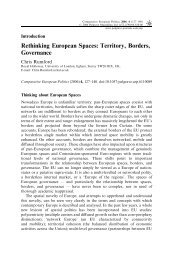Europeanisation, National Identities and Migration ... - europeanization
Europeanisation, National Identities and Migration ... - europeanization
Europeanisation, National Identities and Migration ... - europeanization
Create successful ePaper yourself
Turn your PDF publications into a flip-book with our unique Google optimized e-Paper software.
Polish identity 149<br />
the feeling of ‘being the same’. But by its very nature this answer also implicitly<br />
contains the answer to the question, ‘Who am I not?’, pointing to the distinction<br />
between ingroup <strong>and</strong> outgroup, between ‘us’ <strong>and</strong> ‘them’ (Jacobson-Widding 1983).<br />
Anita Jacobson-Widding calls these two aspects of identity, correspondingly, the<br />
‘sameness’ <strong>and</strong> ‘distinctiveness’. In the case of national identity, the ‘sameness’ is<br />
shaped by the totality of national history, by unique experiences of the nation,<br />
transmitted from one generation to another. The sense of ‘distinctiveness’, on the<br />
other h<strong>and</strong>, can be analysed as a complex product of contacts <strong>and</strong> interactions,<br />
cooperation <strong>and</strong> conflicts with the representatives of other nations.<br />
As Zbigniew Bokszański (1999) points out, an important characteristic of Polish<br />
national identity in the pre-transformation times was its focus on the aspect of ‘sameness’<br />
with a relative neglect of the ‘distinctiveness’ aspect. It can be explained<br />
by pointing to the fact that for a long period of its history, the Polish nation was<br />
deprived of the organisational frames of its own state <strong>and</strong> divided into three parts,<br />
existing under foreign regimes. Under such circumstances, the concentration<br />
on finding constant elements of ‘being a Pole’, even if not living in a ‘Polish’ institutional<br />
environment, was quite natural. However, the same factors which help<br />
us to underst<strong>and</strong> the focus on the continuity aspects, on ‘being the same’ issue, have<br />
also influenced the content of this ‘sameness’. I would like to stress here two of its<br />
specific features.<br />
First, there is the relative unimportance of institutional <strong>and</strong> group symbols of<br />
identity. Not having their own national institutions for a long time, Polish people<br />
attach more significance to moral <strong>and</strong> spiritual characteristics of ‘being a Pole’. This<br />
could explain the distribution of answers within Table 8.5 – on one h<strong>and</strong>, readiness<br />
to accept EU passports, currency <strong>and</strong> emblems, <strong>and</strong> on the other, a resistance to<br />
labels which would, perhaps, hide national inventiveness <strong>and</strong> skilfulness. Jasińska-<br />
Kania (1996) has showed that even in the 1970s <strong>and</strong> the 1980s, irrespective of<br />
whether the self-image constructed by Poles was more positive or more negative<br />
(which was closely related to the actual political <strong>and</strong> economic situation in the<br />
country), it always contained an element of moral superiority <strong>and</strong> exceptionality.<br />
Even our faults were exceptional.<br />
Second, focus on the ‘sameness’ aspect of identity has also resulted in a transference<br />
of the possible divisions between ‘us’ <strong>and</strong> ‘them’ into the boundaries of the<br />
Polish nation. One can say without much exaggeration that for the last 200 years<br />
Poles have been occupied with attempts to refine the concept of a ‘true Pole’. There<br />
are a lot of descriptions in Polish phraseology – starting with a ‘Pole-catholic’,<br />
through ‘Commies’, to one of the most recent inventions: ‘newspaper using the<br />
Polish language’ that is used instead of the title of the leading Polish daily ‘Gazeta<br />
Wyborcza’ – whose main function is to stress the difference between a ‘genuine<br />
Pole’ <strong>and</strong> somebody who only pretends being a Pole or even disguises his real<br />
identity.<br />
There were of course also some demarcation lines between ‘us’ <strong>and</strong> ‘them’ which<br />
included a division between the Polish nation <strong>and</strong> some other nations. Traditionally,<br />
‘them’ referred to the Germans, who in Polish history have been the personification<br />
of an ‘Alien’ <strong>and</strong> always played the role of the main enemy of Pol<strong>and</strong>. For many



